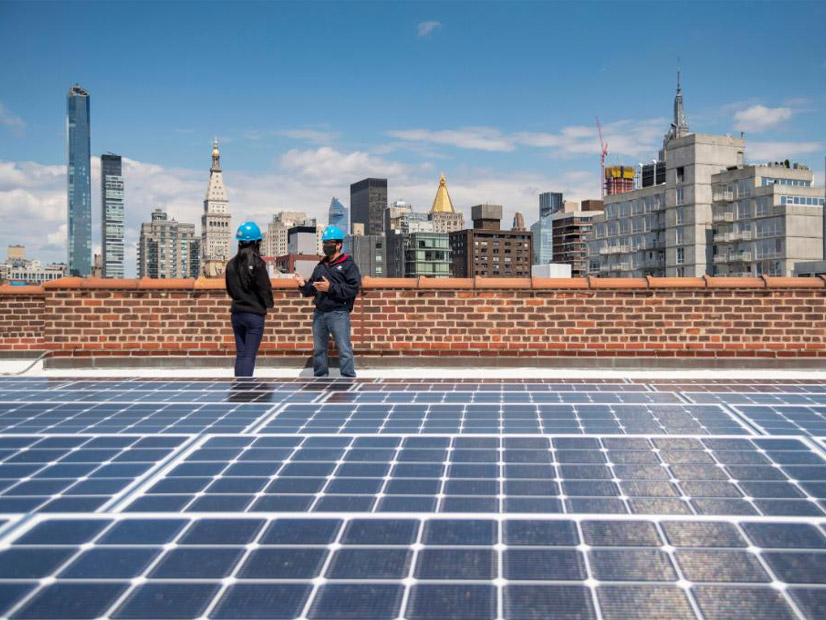Con Edison is staking its future on clean, emissions-free energy, going “all-in” on electric vehicles, energy efficiency and storage, CEO Timothy Cawley said Tuesday.
“Our transition to this clean energy future, that’s what’s going to mark the next few decades for us,” Cawley said. “We know that’s our path forward, so to the extent that certain change culturally is hard, our team has rallied around this and feels good about it.”
Con Edison is the largest investor-owned utility in New York, and its clean energy division is the second-largest solar energy producer in the U.S., he said.
Cawley made his remarks in an interview with Julie Tighe, president of the New York League of Conservation Voters (NYLCV), an event hosted by D.C.-based think tank Our Energy Policy (OEP).
System Adequacy
US Grid Company CEO Jacob Worenklein, also an OEP board member, kicked off the Q&A portion of the event by asking whether Con Edison’s transmission and distribution system is adequate for electrifying the bulk of transportation in New York City, including cars, buses and trucks.
“I’m thinking particularly about the Public Service Commission having turned down what I thought was a modest request by Con Ed a couple of years ago for some increase in transmission/distribution investment authority,” Worenklein said.
The PSC in April approved $800 million in cost recovery by Con Edison for three transmission projects needed for reliability in 2023 and 2025 because of the retirement or unavailability of nearly 400 MW of peaker plants. (See NYPSC OKs $800 Million Tx Cost Recovery for Con Ed.)
Transport and electrification of heating will also add tremendous demand on the grid, Cawley said.
“We are much more granular and specific about including line items for EVs and building heating into our forecasts over the years. So it won’t happen overnight, but we can’t build this stuff overnight either, so we’re going to carefully plan it,” Cawley said.
And the most successful deployment at scale for EVs includes some level of time-of-use rates that encourage people to charge during optimal periods for the grid, he said.
“If you park in a garage … in the outer boroughs or in Westchester or in Orange and Rockland [service territory], you might set a timer and say come on at midnight and charge through 5:00 a.m.,” Cawley said. “Our systems will have a lot of room for a lot of years at that time of day, so effectively we’re getting greater use out of the existing system if we get them to charge there.”
Con Edison’s SmartCharge New York program rewards owners of light-, medium- and heavy-duty EVs with “off-the-bill” incentives for charging during off-peak hours. (See NY Utilities Diverge on Managed EV Charging.)
On the subject of energy storage, Cawley said the company is using the technology to supplement the grid. Rather than investing heavily to reinforce transmission, the aim is just to shave a few megawatts. Even if storage is expensive on a per-unit basis, in the right application it can be cheaper than the alternative.
“So, we’re putting [storage] in Staten Island, and at Nevin Street in Brooklyn is where we’re doing the EV chargers,” Cawley said. “We’re also partnered with a company, 174 Power Global, and will install with that company the largest storage facility in New York state.”
The PSC this spring heard widespread support, including from NYLCV, for Con Ed’s plans to transform the defunct gas-powered Charles Poletti peaker plant on the East River into a 100-MW energy storage system to be built this year and next. (See “New York Supports Con Ed Project” in NYPSC Considers Two Utility Storage Petitions.)
The company puts carbon sequestration in the same category with green hydrogen as technologies that aren’t at scale yet to be economic, but “all of that is on the table for us,” Cawley said.
Customer Engagement
Nancy Najarian, a clean energy and sustainability specialist with NAJ Enterprises, asked, “How can citizens partner with utilities to move them faster towards using clean energy?”
“If you have a home that allows for solar installation, we have tremendous uptick in rooftop solar. I think 47,000 of our customers have installed rooftop solar,” which represents about 400 MW, an “important” amount given the utility’s peak load of 13,000 MW, Cawley said.
“But to me what’s more impressive is the broad interest by our customer base and actually doing this 47,000 times across our service territory,” he said, emphasizing that solar installations on New York City Housing Authority buildings help low- and moderate-income residents both join in the clean energy transition and train for related jobs.
An unidentified participant asked about the role of microgrids going forward, specifically in terms of avoiding major outages, facilitating green energy, reducing emissions and fostering economic development.
If a microgrid is “at the right spot under the right circumstances” it can be valuable for grid resiliency, Cawley said.
“One of the things we’ve done with our grid, really post-Superstorm Sandy, is implement devices and switches that allow us to portion off low-lying areas so we can isolate those without isolating large pieces of neighborhoods in the event of really lousy weather and flood conditions,” Cawley said.
Microgrids also can contribute in terms of emissions, depending on what’s fueling them. Solar with battery backup is a good source of emissions reduction, while some other fuels might not be as productive from that standpoint, he said.


